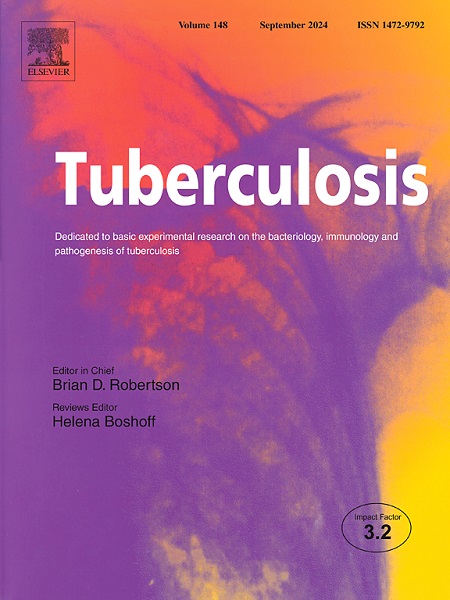血管内皮生长因子A (VEGFA)和M1巨噬细胞标志物一氧化氮合酶2 (NOS2)在牛分枝杆菌接种和未接种牛分枝杆菌感染的牛淋巴结肉芽肿中的差异表达
IF 2.9
3区 医学
Q3 IMMUNOLOGY
引用次数: 0
摘要
牛结核病主要由牛分枝杆菌引起。卡介苗(Bacillus Calmette-Guérin,BCG)是牛分枝杆菌的减毒株,可提供不同程度的疾病保护。受感染牛的病变特征已被确定,但与接种卡介苗的牛的病变进行比较的情况很少。在此,我们使用两组不同的牛,通过原位杂交法检测了牛立克次体 RNA、诱导型一氧化氮合酶 2 和血管内皮生长因子 A 的表达与疫苗接种状况和肉芽肿等级的关系。数据发现,在肉芽肿总面积每μm2或坏死面积每μm2中,疫苗接种组之间或肉芽肿等级之间的波氏杆菌 mRNA 平均拷贝数没有差异。在疫苗接种组中,与低级别肉芽肿相比,高级别肉芽肿每个细胞、每 μm2 和表达 NOS2 的细胞百分比都更高。未接种者产生 NOS2 的细胞比例高于接种者。NOS2表达的差异因组别而异。疫苗接种状况和肉芽肿等级并不影响每个细胞中 VEGFA 的平均拷贝数或表达 RNA 的细胞百分比,但每 μm2 的 VEGFA 拷贝数在不同组间存在差异。这些发现表明,NOS2和VEGFA可能不是卡介苗保护机制,但可能影响疾病的严重程度。本文章由计算机程序翻译,如有差异,请以英文原文为准。
Differential expression of vascular endothelial growth factor A (VEGFA) and M1 macrophage marker nitric oxide synthase 2 (NOS2) in lymph node granulomas of BCG-vaccinated and non-vaccinated cattle infected with Mycobacterium bovis
Bovine tuberculosis is mainly caused by Mycobacterium bovis. Bacillus Calmette-Guérin (BCG) is an attenuated strain of M. bovis which provides variable disease protection. Lesions have been characterized in infected cattle, but little comparison has been done with lesions which form in BCG-vaccinates. Here, in situ hybridization examined differences in expression of M. bovis RNA, inducible nitric oxide synthase 2, and vascular endothelial growth factor A in relation to vaccination status and granuloma grade, using two different groups of cattle. Data found no differences between vaccination groups or granuloma grade in average copies of M. bovis mRNA per μm2 of total granuloma area or per μm2 of necrotic areas. Within a vaccination group high-grade granulomas had more NOS2 per cell, per μm2 and a higher percentage of cells expressing NOS2 than low-grade granulomas. Non-vaccinates had a higher percentage of cells producing NOS2 than vaccinates. Differences in NOS2 expression varied by group. Vaccination status and granuloma grade did not affect the average copies of VEGFA per cell or the percent of cells expressing RNA, however VEGFA copies per μm2 varied between groups. These findings suggest NOS2 and VEGFA are likely not mechanisms of BCG vaccination protection but may impact disease severity.
求助全文
通过发布文献求助,成功后即可免费获取论文全文。
去求助
来源期刊

Tuberculosis
医学-呼吸系统
CiteScore
4.60
自引率
3.10%
发文量
87
审稿时长
49 days
期刊介绍:
Tuberculosis is a speciality journal focusing on basic experimental research on tuberculosis, notably on bacteriological, immunological and pathogenesis aspects of the disease. The journal publishes original research and reviews on the host response and immunology of tuberculosis and the molecular biology, genetics and physiology of the organism, however discourages submissions with a meta-analytical focus (for example, articles based on searches of published articles in public electronic databases, especially where there is lack of evidence of the personal involvement of authors in the generation of such material). We do not publish Clinical Case-Studies.
Areas on which submissions are welcomed include:
-Clinical TrialsDiagnostics-
Antimicrobial resistance-
Immunology-
Leprosy-
Microbiology, including microbial physiology-
Molecular epidemiology-
Non-tuberculous Mycobacteria-
Pathogenesis-
Pathology-
Vaccine development.
This Journal does not accept case-reports.
The resurgence of interest in tuberculosis has accelerated the pace of relevant research and Tuberculosis has grown with it, as the only journal dedicated to experimental biomedical research in tuberculosis.
 求助内容:
求助内容: 应助结果提醒方式:
应助结果提醒方式:


